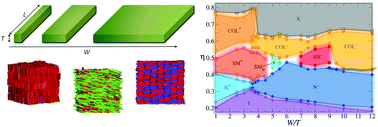Phase behaviour of hard board-like particles†
Abstract
We examine the phase behaviour of colloidal suspensions of hard board-like particles (HBPs) as a function of their shape anisotropy, and observe a fascinating spectrum of nematic, smectic, and columnar liquid-crystalline phases, whose formation is entirely driven by excluded volume effects. We map out the phase diagram of short and long HBPs by gradually modifying their shape from prolate to oblate and investigate the long-range order of the resulting morphologies along the phase directors and perpendicularly to them. The intrinsic biaxial nature of these particles promotes the formation of translationally ordered biaxial phases, but does not show solid evidence that it would, per se, promote the formation of the biaxial nematic phase. Our simulations shed light on the controversial existence of the discotic smectic phase, whose layers are as thick as the minor particle dimension, which is stable in a relatively large portion of our phase diagrams. Additionally, we modify the Onsager theory to describe the isotropic–nematic phase transition of freely rotating biaxial particles as a function of the particle width, and find a relatively strong first-order signature, in excellent agreement with our simulations. In an attempt to shed light on the elusive formation of the biaxial nematic phase, we apply this theory to predict the uniaxial–biaxial nematic phase transition and confirm, again in agreement with simulations, the prevailing stability of the translationally ordered smectic phase over the orientationally ordered biaxial nematic phase.



 Please wait while we load your content...
Please wait while we load your content...